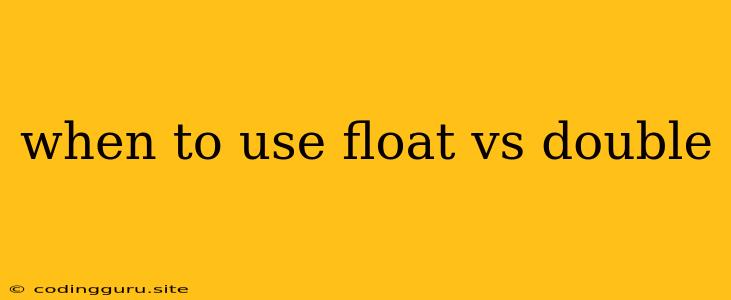When to Use Float vs Double: A Guide to Choosing the Right Data Type
Choosing the right data type for your variables is crucial for efficient and accurate programming. When dealing with numbers that have decimal points, you have two primary options: float and double. While they might seem interchangeable, they have distinct characteristics that make them suitable for different situations. Let's delve deeper into the nuances of float and double to understand when to use each effectively.
What are Floats and Doubles?
Both float and double represent floating-point numbers, meaning they can store values with fractional parts. However, they differ in the amount of memory they occupy and the level of precision they provide.
- float: A float uses 32 bits to store a number, offering a smaller storage space compared to double. This makes it a good choice when memory is a concern, especially when dealing with large datasets.
- double: A double uses 64 bits to store a number, providing double the memory space of a float. This grants it higher precision, allowing it to represent more complex numbers with greater accuracy.
Understanding the Trade-offs: Precision vs. Memory
The key difference between float and double lies in their precision and the amount of memory they consume. Let's break down these trade-offs:
Precision:
- double offers higher precision than float, meaning it can represent numbers with a wider range of decimal places accurately.
- float has a limited precision, making it less suitable for calculations requiring high accuracy.
Memory:
- float uses less memory than double, making it ideal for applications where memory usage is a critical factor.
- double utilizes more memory, which can impact performance, particularly in resource-constrained environments.
When to Use Float?
Consider using float in these scenarios:
- Memory-intensive applications: When dealing with large datasets or working with limited memory resources, float can be a better choice due to its smaller footprint.
- Less demanding calculations: If your calculations do not require extreme precision, float can be sufficient.
- Performance-critical situations: float can improve performance, especially in scenarios involving a large number of calculations, as it requires less processing time.
When to Use Double?
Use double in the following situations:
- High-precision calculations: When accuracy is paramount, such as in scientific simulations, financial modeling, or any field where even minute errors can have significant consequences, double is preferred.
- Complex calculations involving large numbers: double is better equipped to handle calculations involving large numbers with more decimal places accurately.
- Situations where memory is less of a concern: If memory usage is not a major bottleneck, the added precision offered by double outweighs the slightly larger memory footprint.
Illustrative Example: Financial Calculations
Imagine you are building a financial application that needs to handle complex calculations involving interest rates, dividends, and other financial metrics. Since even slight discrepancies in these calculations can have significant financial implications, double would be the more appropriate choice. Its higher precision ensures accurate computations, protecting against potential financial losses.
Tips for Choosing the Right Data Type
Here are some helpful tips to guide your decision-making process:
- Understand the problem domain: Determine the level of precision required for your calculations. Consider the consequences of any potential errors.
- Analyze memory constraints: Evaluate the memory available to your application. Consider the size of your datasets and the potential for memory leaks.
- Test and benchmark: Experiment with both float and double to compare their performance and accuracy in your specific use case.
- Consult documentation: Familiarize yourself with the limitations and characteristics of each data type as documented by your programming language.
Conclusion
The choice between float and double depends on the specific needs of your application. float is suitable for memory-constrained scenarios and less demanding calculations, while double excels in situations requiring high precision and complex calculations. Carefully consider the trade-offs between precision and memory usage to make the most informed decision for your project.
